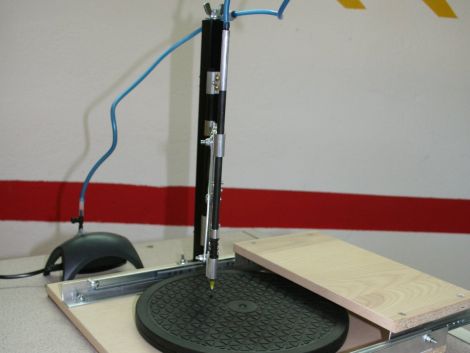
[Erv’] wrote in to share a manual pick and place he recently constructed. He builds a lot of circuits using SMD parts, and after looking at commercial pick and place systems, he decided it would be far cheaper to build his own. Using some components he had sitting around the house, along with a few store-bought pieces, he put the pick and place together for about $50, which is pretty cheap when you think about it.
The base is made from wood he had left over from another project, which has a sliding rail and a movable arm rest built into it. A rotating TV stand is used to hold workpieces, allowing PCBs to be repositioned at will while parts are being laid out. A square furniture leg is used as a support arm, holding the pick and place vacuum pen in place at the end of a small accordion hinge. As in most DIY pick and place installations, a small aquarium pump has been used to provide the suction needed to pick up SMD parts.
It’s a great build with plenty of useful features, and comes in far cheaper than any commercial system you’ll find out there.















Not ready for prime time? I didn’t see any action flicks.
My hand and a pair of good tweezers is a manual pick and place. If you do it enough you will develop a very steady hand and get way faster then a manually operated placement system like this. however add some servos and a vision system for alignment and this could be very very cool.
Ciric
@madcows: that’s because there IS no action to see. This is not a computer controller machine, it’s merely a glorified PCB / SMD pen holder. It’s a tool, you do the pick-and-placing yourself by hand.
I’m working with rather tiny SMDs myself, using pincers no less, but honestly I wouldn’t stop short of an actual CNC pick-and-place if I decided to “upgrade”…
@Max : I use tweezers too occasionally, however it’s not practical when working in large surface PCBs or on panels, as explained in the intro.
even if you want to use tweezers, that sliding wrist rest could be really helpful. cool idea.
@voodoo : you got the point. The vacuum pen can be overkill for many parts, when tweezers can do the job (for resistor, 0603 capacitors etc) but traveling above the board is really nice.
The pen finds its use for big parts, like when you need to place a 64 TSSOP chip in one shot without messing the solder paste.
Bottom line : it’s a modular tool, you can use it in different ways depending on the board size or the parts you need to place !
Magnetic coil maybe?
Wind it around one of those metglas security tags coiled up inside a small straw or heatshrink etc and then it concentrates the field like a permanent magnet but is then switchable with no remanence.
:-)
@bothersaidpooh : someone posted a very cool automated pick and place using a small magnet for the placing head. However, it doesn’t work well for resin parts (IC, mostly). CNC pick and place use vacuum in general for that reason since it works for everything, if you have the right sucking cup.
I’ve actually built a handheld pneumatic tweezer with tubing, a bic pen with a “carburetor” and a mini vacuum vortex thing (I forget the technical term for it) hooked to my compressor. I wonder if you could use it in conjunction with a fish pump for even cheaper…
The noise aquarium pumps make is soooooo annoying though, and for me unbearable.
@Whatnot Yep annoying and useless. I tried a few different aquarium pumps and they all didn’t suck (pun intended).
I would suggest anyone wanting to build a manual Pick and Place shell out the cash for a more powerful vacuum. I have one on my hot air rework station and that works quite handily.
sounds you all got the wrong pump then. Mine is noise less, and mounted on anti vibratory pads. And it sucks from 0402 parts to big TQFP ICs.
voodoo wrote:
“even if you want to use tweezers, that sliding wrist rest could be really helpful. cool idea.”
Many artists use a device called a “mahl stick” to support their hands/wrists above the drawing surface.
A mahl stick is basically just a stick with a soft cushion at the end so that it doesn’t gouge the surface you rest it on. Here are some pics:
http://www.wetcanvas.com/Articles2/14892/269/images/IMAGE6.jpg
http://lindateachesart.typepad.com/linda_teaches_art/images/mahl_010_4.jpg
http://www.rockyburris.com/images/How_To_Hold_A_Brush_img_7.jpg
Something similar could be used for electronics.
And here is a different type of wrist support that could also be useful:
http://www.wetcanvas.com/Community/images/13-Jan-2010/199286-Bridge.JPG